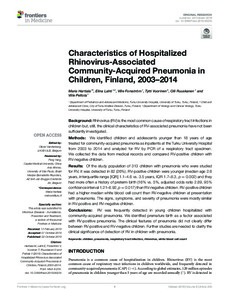Characteristics of Hospitalized Rhinovirus-Associated Community-Acquired Pneumonia in Children, Finland, 2003–2014
Vuorinen T; Hartiala M; Ruuskanen O and Peltola V; Forsström V; Lahti E
https://urn.fi/URN:NBN:fi-fe2021042825298
Tiivistelmä
Background: Rhinovirus (RV) is the most common cause of respiratory tract infections in children but, still, the clinical characteristics of RV-associated pneumonia have not been sufficiently investigated.
Methods: We identified children and adolescents younger than 18 years of age treated for community-acquired pneumonia as inpatients at the Turku University Hospital from 2003 to 2014 and analyzed for RV by PCR of a respiratory tract specimen. We collected the data from medical records and compared RV-positive children with RV-negative children.
Results: Of the study population of 313 children with pneumonia who were studied for RV, it was detected in 82 (26%). RV-positive children were younger (median age 2.6 years, interquartile range [IQR] 1.1–4.6 vs. 3.5 years, IQR 1.7–8.3, p = 0.002) and they had more often a history of preterm birth (16% vs. 5%, adjusted odds ratio 2.89, 95% confidence interval 1.21–6.92, p = 0.017) than RV-negative children. RV-positive children had a higher median white blood cell count than RV-negative children at presentation with pneumonia. The signs, symptoms, and severity of pneumonia were mostly similar in RV-positive and RV-negative children.
Conclusions: RV was frequently detected in young children hospitalized with community-acquired pneumonia. We identified premature birth as a factor associated with RV-positive pneumonia. The clinical features of pneumonia did not clearly differ between RV-positive and RV-negative children. Further studies are needed to clarify the clinical significance of detection of RV in children with pneumonia.
Kokoelmat
- Rinnakkaistallenteet [19207]
